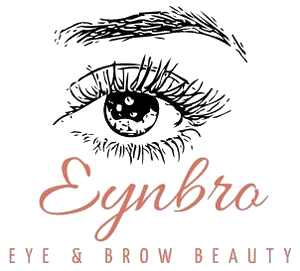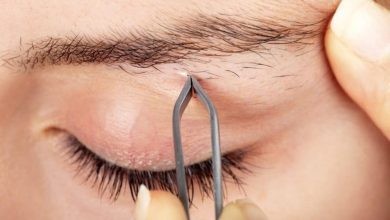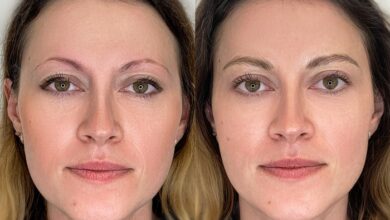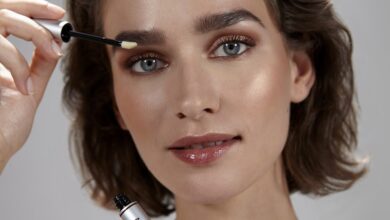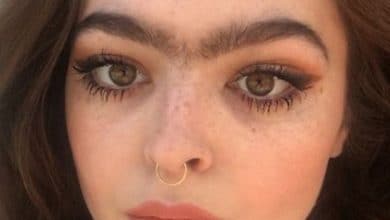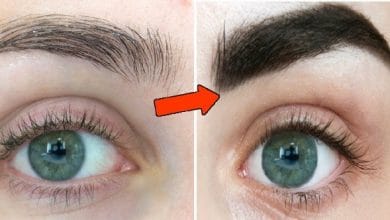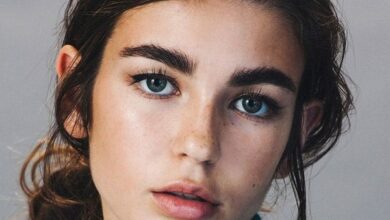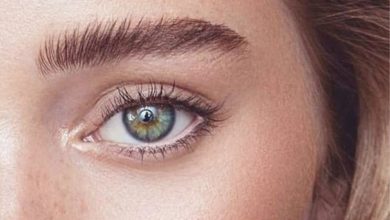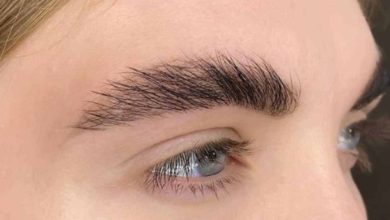Are eyebrows considered facial hair?

The eyebrow is an area of short hair above each eye that follows the shape of the lower edge of the brow bones in some mammals. In humans, eyebrows serve two main functions: first, they allow for communication through facial expression, and second, they prevent sweat, water and other debris from falling into the eye socket. It is common for people to modify their eyebrows through hair removal and makeup.
Not in the sense that if someone asks “do they have facial hair?” you would say yes even if they only had eyebrows and nothing else. It’s about facial hair, but not what people are referring to with that term. In practice, facial hair refers to “hair on the face where it usually grows in men but not in women”: chin, upper neck, cheeks, temples, under the nose. They may be present on your face, but facial hair is what grows later in life (for example, when a man wears a mustache, etc.) and you are born with eyebrows.
A number of theories have been proposed to explain the function of the eyebrow in humans. One theory suggests that the main function of the eyebrow is to prevent moisture (mainly sweat and rain) from entering the eye. Another theory holds that conspicuous eyebrows provided security from predators when early hominid groups began to sleep on the ground.
Recent research, however, suggests that human eyebrows developed as a means of communication and that this is their primary function. Humans have developed a smooth forehead with visible, hairy eyebrows capable of a wide range of movement. These eyebrows can express a wide range of subtle emotions – including recognition and sympathy.
Is female facial hair normal?
Unwanted or excessive hair growth on a woman’s body and face is due to hirsutism, a common condition that affects 5-10% of women. Hirsutism is defined as the presence of disproportionate male-like hair in certain parts of a woman’s body (called androgenic body parts).

Technically speaking, it should be considered facial hair. Realistically speaking, its not. Everybody has eyebrows, not everyone has “facial hair”, I personally classify it as hair below the nose.
Too much hair can often cause embarrassment and even guilt, but is not immediately dangerous. However, a woman’s health may be at risk due to the underlying hormonal imbalance that causes it.
Hair on the face and body is normal for women. However, the texture of the hair is usually very fine and light in color. In the case of hirsutism, hair grows in a thick, dark, coarse male pattern and can be seen on the female:
- the face
- chin
- sideburns
- chest and periareolar area
- lower abdomen
- upper and lower back
- upper part of the inner thighs
Do eyebrows grow as fast as facial hair?
It used to be believed that when eyebrows were shaved or lost, they would not grow back. However, unless you have an underlying medical condition that is causing your hair loss, your eyebrows should grow back.
A research study published in 1999 debunked this myth by showing that shaved eyebrows grow back normally. In this study, one eyebrow was shaved off in five people and the other eyebrow was left for comparison.
The regrowth was assessed over six months using photos taken at each follow-up. With the exception of one participant with light, sparse eyebrows who took six months to grow back completely, all other participants’ eyebrows grew back normally within four months.
The functional characteristics of eyebrows

- Eyebrows are there to channel the undesired moisture, sweat, and raindrops away from the eye to retain clear vision. The shape and direction of the eyebrows force the moisture to flow sideways.
- Eyebrows are meant to block the light and dust particles, hence avoid its falling within the eyes.
- Experts believe that human communication and expression are well expressed by the eyebrow movement.
- Research by the Massachusetts Institute of Technology (MIT) confirmed that eyebrows are a key feature in a person’s identity, even more than the eyes.
Like every other hair of the body, eyelashes and eyebrows follow a life cycle, comprising three phases. However, these phases are not synchronized. Some hair may stay in one phase more than the other. This is why we don’t shed our hair altogether.
The three phases of hair growth are:
- anagen, the active growth phase
- catagen, an intermediate phase that lasts two or three weeks, when growth stops and the follicles shrink
- the telogen phase, a phase of rest and loss at the end of which the old hair falls out to make way for the new ones.
The length of the hair depends on the length of the anagen phase. Eyebrows grow more slowly than scalp hair and have a much shorter anagen phase. Eyebrows grow from 0.14 mm to 0.16 mm per day.
Is it bad to shave female facial hair?
In keeping with hair removal, facial shaving can also be used as a mechanical (physical) exfoliator to remove dead skin cells. This may be a “pro” for some women, but a “con” for others.
Before picking up the razor, examine your skin. If you have conditions such as eczema, psoriasis or acne, shaving can exacerbate irritation and discomfort. It can also lead to infection.
Sensitive skin, or skin that has red, irritated patches for some reason, may also not respond well to shaving.
If your skin is fair and can handle exfoliation, shaving has definite benefits, but also potential drawbacks:
Benefits of facial shaving for women
- Clean sheet. Shaving the face removes hair, debris, excess oil and dead skin cells, which can lighten the appearance of the skin. This makes makeup easier to apply and longer lasting.
- Self-confidence. Some people are self-conscious about facial hair. If you feel more confident and better about yourself by shaving, it probably makes sense to do so.
Disadvantages of facial shaving for women
- Five-Hour Shade. If you shave to remove terminal hair, you may need to shave more often to get it under control. If you have a lot of dark hair, you may see a shadow under your skin after shaving.
- Ingrown hairs. Shaving the vellus hairs doesn’t cause ingrown hairs, but shaving the terminal hairs can cause these painful bumps to appear.
- Skin damage. Shaving carries the risk of nicks and cuts that can bleed and sting. Shaving can also cause razor burn.
- Dryness and itching. If you have dry skin, shaving can further dry it out and cause discomfort. It can also cause flaking and itching. Moisturizing immediately after shaving should help you avoid this.
When should a girl start shaving her face?
Whereas some parents believe there is an appropriate age at which shaving becomes more socially acceptable, other mothers feel they can avoid the topic until their daughters begin to ask, which may be long before or long after that predetermined age/number is reached. Today’s Parent points out that there are maturity factors at play here, as well as societal factors and personal perspectives; some mothers want their daughters to know that there is no need to shave if they don’t want to.
Each little girl has different feelings about her body hair, including where it grows, and let’s face it, moms have different perspectives on this topic as well.
Do eyebrows make you look prettier?
If the eyes are the windows to the soul, the eyebrows are the curtains that show them off. We actually depend on the eyebrows to understand what a person is feeling and communicating. For example, raised eyebrows can convey happiness or shock, depending on the circumstances, and crinkled or furrowed eyebrows can convey anything from sorrow to confusion. If they are poorly done, your eyebrows can give the impression that you have a permanent anxious expression. When done right, and shaped to match your face shape, they can accentuate all the right features and give you a polished look. Eyebrows are such an important feature and a simple change in their shape can change your entire look. You can go from simple and sophisticated to sexy and glamorous with an eyebrow arch. Eyebrow shaping can be done in a number of ways, whether it’s with tweezers, thread or wax. However, most people overlook the fact that eyebrow filling can be just as beneficial as waxing. Eyebrow filling can help bring out the best in your features.
Do guys notice facial hair?
The answer is that many men first notice a woman’s fine, soft hair (lanugo). But many men also said they pretend not to notice.
Of the women surveyed, 1 in 5 said they don’t pay much attention to their facial hair or barely notice it. In contrast, 40% of men responded that during an intimate relationship, a woman’s facial hair is the first thing they notice. However, about 40 percent of men said they would never make a comment about it to their wife, girlfriend or lover.
The survey also showed that men tend to notice facial hair more than black pores, open pores, panda eye bags and rough lips. The same survey revealed that women are most concerned about black pores.
The cycle of a woman’s facial lanugo (loss and growth) is said to be 20 days. Therefore, the ideal is to shave the lanugo every 20 days or once a month.
For shaving, it is best to avoid the menstrual period, after a sunburn and when the skin is sensitive. When not bathing, keep the razor in a sanitary place and use a safe and clean razor.
Female facial hair is a problem that can ruin a potential relationship. In order to go about your business with a dazzling look and confidence, unwanted facial hair should be taken care of properly.
Is eyebrow shape genetic?
Facial hair is a secondary sex characteristic of human males. Women are also capable of developing facial hair, especially after menopause, though typically significantly less than men.
Scientists have established that the shape, color and thickness of your eyebrows are inherited traits.
In a major 2015 study, scientists found a strong relationship between the inheritance of specific genes and the appearance of eyebrows.
Four distinct genes can affect eyebrow hair texture, one gene can determine eyebrow shape, five genes affect eyebrow hair color, and one gene determines whether or not you develop a unibrow.
But environmental factors also have a lot to do with the appearance of your eyebrows. Years of waxing or tweezing can permanently affect the shape of your eyebrows. Skin damage near the eyebrows can also affect hair growth and eyebrow shape.
Just as eyebrow characteristics are inherited, so are eyebrow abnormalities. One of the most common eyebrow abnormalities is madarosis, or eyebrow loss. The term madarosis can also refer to the loss of eyelashes. This phenomenon can be caused by many different hereditary diseases.
Is it normal to have a little hair between your eyebrows?
Hair between the eyebrows is completely normal, and most girls and women experience it throughout their lives, so don’t worry. The easiest way to get rid of them is to borrow mom’s tweezers and slowly and carefully pluck the stray hairs. To avoid plucking too much, use your fingers as a guide: hold both hands, index fingers pointing up, on either side of your nose. The general rule of thumb is to pluck the visible hair in the space between your fingers, but to be safe, start in the middle and work your way out, moving away from the mirror every few hairs to make sure you don’t go too far. Remember: you can always pluck more, but if you pluck too much, you’ll have to wait a few weeks for those hairs to grow back!
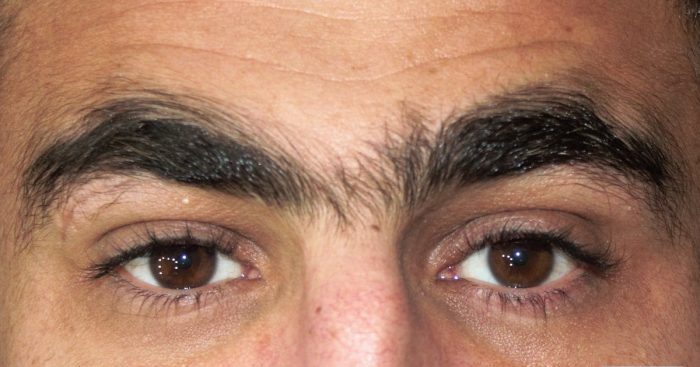
One more thing: talk to your mom before you go hair crazy, okay? She might offer to show you how, or she might do it for you. Some chicas also get their stray eyebrow hairs plucked. If you’re interested in this option, ask your mom or another trusted adult if they would be willing to take you to a salon that does facial waxing.
What causes long eyebrow hair?
The hair cycle, as well as the structure of the hair follicle, is strongly influenced by various hormones. In particular, men often have high levels of androgens, including testosterone, while women tend to have lower levels of androgens. These androgens are the reason men’s hair grows faster, she added.
During puberty, these androgens are responsible for hair growth in places like the face, arms and back. These androgens act on sex-specific parts of the body, such as the pubic area, chest, face and axillary [underarm] areas during puberty. They act as a stimulus for hair.
As we age, some hair follicles become more sensitive to these hormones. As follicles become more sensitive to androgens, the hormones keep them in the anagen phase longer, resulting in more hair growth with age in places like the eyebrows, nose and ears.
Interestingly, and somewhat mysteriously, hair follicles on the scalp respond differently to testosterone and shorten their growth cycle when testosterone levels increase. This is why some older men have shaggy eyebrows, long nose hair and bushy ear hair, but a bald head.
Men’s eyebrows tend to continue to grow into old age (this also applies to nose and ear hair). In women, testosterone levels are lower.
As women age, estrogen levels decrease during menopause. According to the 2021 study, lower estrogen levels, combined with other hormonal changes and aging factors, would result in thinner, less dense hair. While men continue to produce androgens into their 70s, women’s hormones deplete with menopause, around age 50.
Which grows faster head hair or facial hair?
It grows faster at first and because it is thicker and a little harder than hair, it takes longer. If you compare it to hair, it grows much faster. The growth rate in the initial stage is faster but as soon as it reaches half an inch, the rate decreases. The rate of growth decreases in comparison to the head. The scalp and the face have different hair follicles, they are not the same. The face is soft and the scalp is harder. The scalp is much denser than the face. But it all depends on hormonal and genetic science.
Hair covers our entire body, except for our lips, palms and soles. In fact, we have on average the same amount of hair per square centimeter as chimpanzees (for this reason alone, it is fundamentally wrong to call humans “hairless apes”). However, our hair comes in many forms. On the body, we wear a delicate downy coat, which is virtually invisible. But on the head, in the armpits and on the face in men grow long hair (we call them directly). Men’s long hair is about twice as thick as women’s.
Hair grows upwards (perpendicular to the surface of the skin or, at most, at an angle of 60-70 degrees). This is why it is natural for short, straight hair to stick out like a “hedgehog”. Hair will lie down under its own weight if you grow it long enough.
Hair grows because new cells are constantly forming in the hair follicle, maturing, drying and keratinizing, lengthening the hair shaft (the visible part of the hair). On average, hair grows at a rate of 0.3 to 0.8 mm per day, or just over 1 cm per month.
Hair grows fastest on the face. Any man who shaves his beard knows this from experience. Already five hours after shaving, a hand on the face reveals a tangible beard.
Conclusion
Eyebrows are there for a reason, and it’s not just about cosmetics. Although these two are made up of hair, they are not considered facial hair. The term “facial hair” refers to a mustache, beard and/or sideburns, not eyebrows and eyelashes. They can be. They are hairs on your face. When we say “facial hair” people think of beards, mustaches and goatees. So, if someone comes to you and says that eyebrows are facial hair, share this blog with them.
